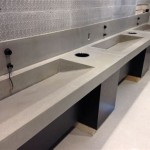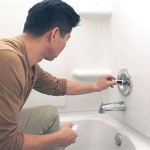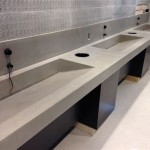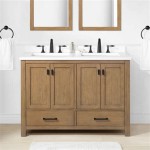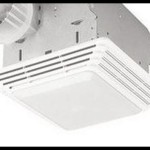How to Paint Over Laminate Bathroom Countertops
Laminate countertops, a common feature in many bathrooms, often present a practical and affordable surface. However, their aesthetic appeal can wane over time, leading homeowners to consider replacement. Painting laminate countertops offers a cost-effective and less disruptive alternative to complete replacement, providing an opportunity to update the bathroom's appearance without extensive renovations.
Successfully painting laminate requires careful preparation, the use of appropriate materials, and meticulous application. This article outlines the necessary steps to achieve a durable and aesthetically pleasing finish on laminate bathroom countertops.
Surface Preparation: The Foundation for a Lasting Finish
Proper surface preparation is paramount to ensuring the paint adheres correctly and resists chipping and peeling. Laminate surfaces are inherently smooth and non-porous, making it difficult for paint to grip. The following steps are essential for creating a sound foundation for the new paint layer.
Cleaning: The initial step involves thoroughly cleaning the countertop surface. This removes any existing dirt, grease, soap scum, or other contaminants that could interfere with paint adhesion. Use a strong degreaser, such as trisodium phosphate (TSP), following the manufacturer’s instructions carefully. Apply the cleaner with a non-abrasive sponge or cloth, paying particular attention to areas that may have accumulated grime. Rinse the surface thoroughly with clean water to remove any residue from the cleaning solution. Allow the countertop to dry completely before proceeding to the next step.
Sanding: Sanding is a critical step in preparing laminate for painting. It roughens the smooth surface, creating a mechanical bond for the primer and paint to adhere to. Use a medium-grit sandpaper, such as 120-grit, to lightly sand the entire surface of the countertop. Apply consistent pressure and avoid sanding too aggressively, as this can damage the laminate. The goal is to create a slightly textured surface, not to remove the laminate layer. Pay particular attention to edges and corners, where chipping is more likely to occur. After sanding, use a tack cloth or a damp cloth to remove all sanding dust. This step is essential for achieving a smooth and even paint finish.
Priming: Priming is an indispensable step in painting laminate countertops. Primer acts as a bonding agent, creating a stable base for the paint to adhere to. Use a high-quality bonding primer specifically designed for slick surfaces, such as those labeled for use on laminate or glossy surfaces. Apply the primer evenly using a high-quality brush or roller, ensuring that all areas of the countertop are covered. Allow the primer to dry completely according to the manufacturer’s instructions. Multiple coats of primer may be necessary, especially if the existing laminate is dark in color. Lightly sand the primed surface with a fine-grit sandpaper (220-grit) to smooth out any imperfections before applying the paint.
Selecting the Right Paint and Application Techniques
The choice of paint significantly impacts the durability and aesthetic appeal of the finished countertop. Selecting a paint formulated for durability and moisture resistance is crucial for a bathroom environment. The application technique is equally important for achieving a professional-looking result.
Paint Selection: For laminate bathroom countertops, epoxy paints or specialized countertop paints are generally recommended. These paints are formulated to withstand moisture, scratches, and everyday wear and tear. Epoxy paints offer excellent durability and a hard, glossy finish. Countertop paints, often acrylic-based, are formulated for adhesive qualities and resistance to common bathroom chemicals. Consult with a paint specialist at a local hardware store to determine the best option based on the specific project requirements and desired finish. Consider factors such as the color, sheen, and ease of application when making a decision. Always opt for a paint that’s specifically designed for use on countertops or in high-moisture environments.
Application Techniques: Apply the paint in thin, even coats to prevent drips and runs. Use a high-quality brush, roller, or paint sprayer, depending on the type of paint and the desired finish. For brush application, choose a brush with synthetic bristles to avoid brush marks. For roller application, use a foam roller to achieve a smooth finish. Paint sprayers can provide a seamless, professional-looking finish but require more preparation and skill. Follow the manufacturer’s instructions for paint application, including the recommended drying time between coats. Allow each coat to dry completely before applying the next one. Multiple coats are typically required to achieve full coverage and a durable finish. Lightly sand between coats with fine-grit sandpaper to smooth out any imperfections, and use a tack cloth to remove any sanding dust.
Sealing: Applying a clear topcoat or sealant is essential for protecting the painted surface and enhancing its durability. A polyurethane or epoxy sealant will provide a moisture-resistant and scratch-resistant barrier. Apply the sealant in thin, even coats, following the manufacturer’s instructions. Allow each coat to dry completely before applying the next one. Multiple coats may be necessary to achieve the desired level of protection. Consider the sheen of the sealant when making a selection. A glossy sealant will provide a high-shine finish, while a matte sealant will provide a more subtle look. Allow the sealant to cure completely before using the countertop. This may take several days, depending on the product and environmental conditions.
Addressing Potential Issues and Ensuring Longevity
While painting laminate countertops can be a successful DIY project, certain issues can arise that require attention. Addressing these issues promptly and proactively can significantly extend the lifespan of the painted countertop.
Chipping and Peeling: Chipping and peeling are common issues that can occur if the surface is not properly prepared or if the wrong type of paint is used. If chipping occurs, sand the affected area smooth and reapply primer and paint. To prevent chipping, avoid placing heavy or sharp objects directly on the countertop. Use cutting boards and trivets to protect the surface. If peeling occurs, it may be necessary to remove the entire paint layer and start over with proper surface preparation and paint selection. Adhering to the preparation steps detailed above is crucial to prevent this issue.
Water Damage: Water damage can cause the paint to blister or peel. To prevent water damage, wipe up spills immediately and avoid leaving standing water on the countertop. Ensure that the sealant is properly applied and maintained to provide a waterproof barrier. Consider using a waterproof caulking along the edges of the countertop to prevent water from seeping underneath. Regularly inspect the countertop for any signs of water damage, such as discoloration or bubbling, and address the issue promptly.
Maintaining the Painted Surface: Regular cleaning and maintenance are essential for preserving the appearance and extending the lifespan of the painted countertop. Clean the surface regularly with a mild soap and water. Avoid using abrasive cleaners or harsh chemicals, as these can damage the paint or sealant. Use a soft cloth or sponge to clean the surface, and avoid scrubbing too vigorously. Periodically inspect the countertop for any signs of wear and tear, such as scratches or chips, and touch up as needed. Applying a fresh coat of sealant every few years can also help to maintain the protective barrier and extend the lifespan of the painted surface.
By following these steps and addressing potential issues proactively, homeowners can successfully paint their laminate bathroom countertops and achieve a durable and aesthetically pleasing finish. While painting provides a cosmetic upgrade, understanding its limitations compared to a full replacement is crucial for setting realistic expectations regarding durability and longevity.

How To Refinish Laminate Counters Made By Marzipan
:strip_icc()/101922779-2cbc45e123c34827afb4f601723b03ca.jpg?strip=all)
How To Paint Bathroom Countertops

Paint Bathroom Vanity Countertop Sink So Easy A Piece Of Rainbow

How To Paint A Laminate Countertop Quick Easy Inexpensive

Paint Bathroom Vanity Countertop Sink So Easy A Piece Of Rainbow

How To Easily Spray Paint Bathroom Countertops My Homier Home

I Chalk Painted My Countertops Lolly Jane

Painting Laminate Cabinets And Countertop Under 100 Crazy Life With Littles

Paint Bathroom Vanity Countertop Sink So Easy A Piece Of Rainbow

I Chalk Painted My Countertops Lolly Jane
Related Posts
